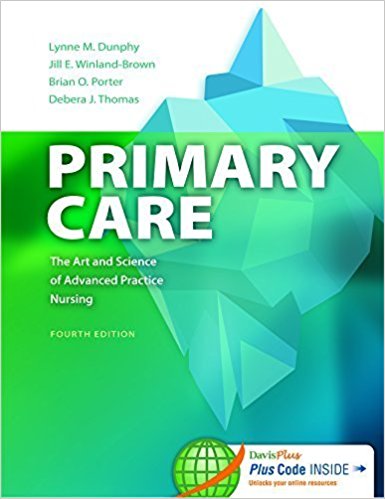Test Bank For Primary Care, Art and Science of Advanced Practice Nursing 4th Edition by Dunphy
Digital item No Waiting Time Instant DownloadISBN-13: 978-0803638013 ISBN-10: 9780803638013
In Stock
Original price was: $75.00.$28.00Current price is: $28.00.
Test Bank For Primary Care, Art and Science of Advanced Practice Nursing 4th Edition by Dunphy
Chapter 6. Neurological Problems
Multiple Choice
Identify the choice that best completes the statement or answers the question.
____ 1. Which statement about confusion is true?
|
a. |
Confusion is a disease process. |
|
b. |
Confusion is always temporary. |
|
c. |
Age is a reliable predictor of confusion. |
|
d. |
Polypharmacy is a major contributor to confusion in older adults. |
____ 2. Sondra’s peripheral vestibular disease causes dizziness and vertigo. Which of the following medications will help to decrease edema in the labyrinth of the ear?
|
a. |
Meclizine |
|
b. |
Diphenhydramine |
|
c. |
Diamox |
|
d. |
Promethazine |
____ 3. The hallmark of an absence seizure is:
|
a. |
No activity at all |
|
b. |
A blank stare |
|
c. |
Urine is usually voided involuntarily |
|
d. |
The attack usually lasts several minutes |
____ 4. How often should drug levels be monitored when a seizure medication has controlled the seizures, and the drug level is adequate?
|
a. |
Every 3 months |
|
b. |
Every 6 months |
|
c. |
Annually |
|
d. |
Whenever there is a problem |
____ 5. Which of the following persons fits the classic description of a patient with multiple sclerosis (MS)?
|
a. |
A teenage male |
|
b. |
A 65-year-old male |
|
c. |
A 25-year-old female |
|
d. |
A 60-year-old female |
____ 6. Which of the following is a specific test to MS?
|
a. |
Magnetic resonance imaging (MRI) |
|
b. |
Computed tomography (CT) scan |
|
c. |
A lumbar puncture |
|
d. |
There is no specific test. |
____ 7. Which drug for Alzheimer’s disease should be administered beginning at the time of diagnosis?
|
a. |
Cholinesterase inhibitors |
|
b. |
Anxiolytics |
|
c. |
Antidepressants |
|
d. |
Atypical antipsychotics |
____ 8. Which hematoma occurs along the temporal cranial wall and results from tears in the middle meningeal artery?
|
a. |
Epidural hematoma |
|
b. |
Subdural hematoma |
|
c. |
Subarachnoid hematoma |
|
d. |
Intraparenchymal hemorrhage |
____ 9. Which cranial nerve is affected in a patient with a cerebrovascular accident who has difficulty chewing?
|
a. |
CN V |
|
b. |
CN VII |
|
c. |
CN IX |
|
d. |
CN X |
____ 10. Which statement best describes a carotid bruit?
|
a. |
It is felt with the middle three fingers over the carotid artery. |
|
b. |
A bruit becomes audible when the lumen is narrowed to 1 mm or less. |
|
c. |
A low-pitched bruit is a medical emergency. |
|
d. |
The higher the pitch of the bruit, the higher the degree of stenosis. |
____ 11. Which patient is more likely to have a cluster headache?
|
a. |
A female in her reproductive years |
|
b. |
A 40-year-old African American male |
|
c. |
A 55-year-old female who drinks 10 cups of coffee daily |
|
d. |
A 45-year-old male awakened at night |
____ 12. Inattention and a sleep-wake cycle disturbance are the hallmark symptoms of?
|
a. |
Dementia |
|
b. |
Alzheimer’s disease |
|
c. |
Parkinson’s disease |
|
d. |
Delirium |
____ 13. Which type of meningitis is more benign, self-limiting, and caused primarily by a virus?
|
a. |
Purulent meningitis |
|
b. |
Chronic meningitis |
|
c. |
Aseptic meningitis |
|
d. |
Herpes meningitis |
____ 14. Which is the most sensitive neuroimaging test to evaluate patients with encephalitis?
|
a. |
MRI |
|
b. |
CT |
|
c. |
Electroencephalogram (EEG) |
|
d. |
An initial lumbar puncture |
____ 15. What is usually the first sign or symptom that a patient would present with that would make you suspect herpes zoster?
|
a. |
A stabbing pain on one small area of the body |
|
b. |
A vesicular skin lesion on one side of the body |
|
c. |
A pain that is worse upon awakening |
|
d. |
A lesion on the exterior ear canal |


Reviews
There are no reviews yet.